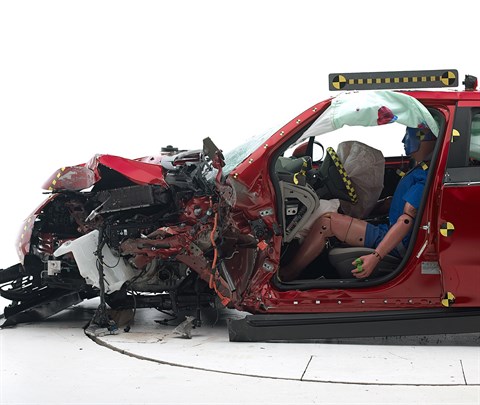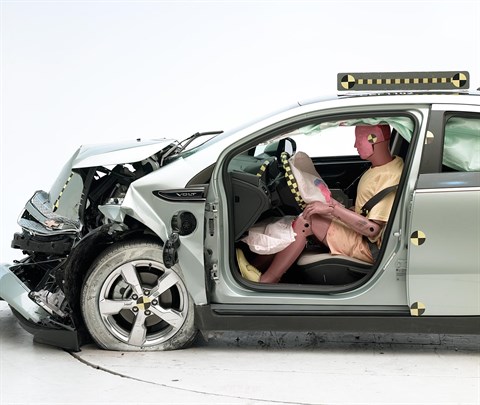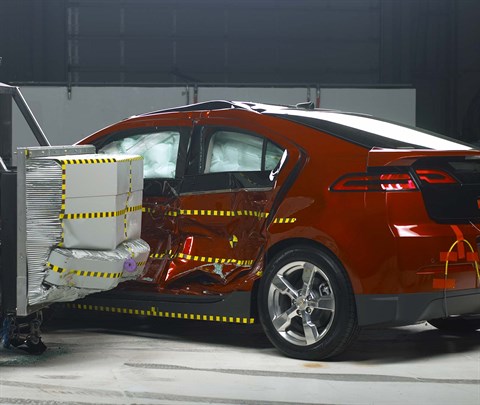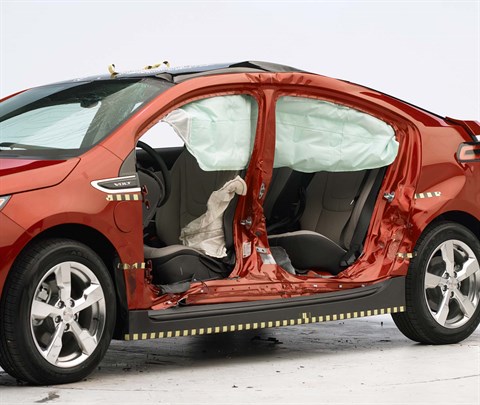Small overlap front: driver-side
Rating applies to 2014-15 models
Tested vehicle: 2014 Chevrolet Volt 4-door
The Chevrolet Volt was introduced in the 2011 model year. The car is a plug-in battery-electric/gasoline hybrid, featuring an electric-only mode with a range of 38 miles for 2014 models according to the EPA. After the electric-only mode ends, the gas engine kicks in to power the vehicle.
Beginning with 2014 models, the front structure was modified to improve occupant protection in small overlap frontal crashes.
| Evaluation criteria | Rating |
|---|---|
| Structure and safety cage | |
| Driver injury measures | |
| Head/neck | |
| Chest | |
| Hip/thigh | |
| Lower leg/foot | |
| Driver restraints and dummy kinematics The dummy’s head barely contacted the frontal airbag before sliding off the left side, leaving the head vulnerable to contact with forward structure. The side curtain airbag deployed and had sufficient forward coverage to protect the head from contact with side structure and outside objects. | |

Action shot taken during the small overlap frontal crash test.

The dummy's position in relation to the door frame, steering wheel, and instrument panel after the crash test indicates that the driver's survival space was maintained reasonably well.

During the crash, the dummy's head and torso barely contacted the frontal airbag before sliding off to the left. The side curtain airbag extended far enough forward toward the A-pillar to protect the head from contact with forward side structure.

The driver's space was maintained reasonably well, and risk of injuries to the dummy's legs and feet was low.
Moderate overlap front: original test
Rating applies to 2011-15 models
Tested vehicle: 2011 Chevrolet Volt 4-door
The Chevrolet Volt was introduced in the 2011 model year. The car is a plug-in battery-electric/gasoline hybrid, featuring an electric-only mode with a range of 35 miles for 2011 models according to the EPA. After the electric-only mode ends, the gas engine kicks in to power the vehicle.
| Evaluation criteria | Rating |
|---|---|
| Overall evaluation | |
| Structure and safety cage | |
| Driver injury measures | |
| Head/neck | |
| Chest | |
| Leg/foot, left | |
| Leg/foot, right | |
| Driver restraints and dummy kinematics | |

Action shot taken during the frontal offset crash test.

The dummy's position in relation to the steering wheel and instrument panel after the crash test indicates that the driver's survival space was maintained very well.

Smeared greasepaint indicates where the dummy's head contacted the side curtain airbag during rebound.

Intrusion into the driver's space was minimal, and all leg and foot injury measures were low.
Side: original test
Rating applies to 2011-15 models
Tested vehicle: 2011 Chevrolet Volt 4-door with front and rear head curtain airbags and front seat-mounted torso airbags
The Chevrolet Volt was introduced in the 2011 model year. The car is a plug-in battery-electric/gasoline hybrid, featuring an electric-only mode with a range of 35 miles for 2011 models according to the EPA. After the electric-only mode ends, the gas engine kicks in to power the vehicle.
| Evaluation criteria | Rating |
|---|---|
| Overall evaluation | |
| Structure and safety cage | |
| Driver injury measures | |
| Head/neck | |
| Torso | |
| Pelvis/leg | |
| Driver head protection | |
| Rear passenger injury measures | |
| Head/neck | |
| Torso | |
| Pelvis/leg | |
| Rear passenger head protection | |

View of the vehicle and barrier just after the crash test.

View of the vehicle after the crash with doors removed, showing the side airbags and damage to the occupant compartment.

Smeared greasepaint shows where the driver dummy's head was protected from being hit by hard structures by the side airbags.

Smeared greasepaint shows where the rear passenger dummy’s head was protected by the side airbag.
Roof strength
Rating applies to 2011-15 models
Tested vehicle: 2011 Chevrolet Volt 4-door
| Overall evaluation | |
|---|---|
| Curb weight | 3,739 lbs |
| Peak force | 15,816 lbs |
| Strength-to-weight ratio | 4.23 |
Head restraints & seats
Seat type: Manual cloth seat
| Overall evaluation | |
|---|---|
| Dynamic rating | |
| Seat/head restraint geometry |
About the head restraint & seat test
Currently, IIHS tests apply only to front seats.
